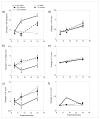Patching fellow eyes during subjective night does not prevent disruption to minus lens compensation in constant light-reared chicks
- PMID: 18585401
- PMCID: PMC2567919
- DOI: 10.1016/j.visres.2008.06.001
Patching fellow eyes during subjective night does not prevent disruption to minus lens compensation in constant light-reared chicks
Abstract
Purpose: This study re-examined an earlier claim that monocular patching during subjective night (i.e. patched at the usual time that night would occur) in the chicks reared in continuous lighting (CL), offered unpatched eyes some protection from the ocular effects of CL. It also examined whether this monocular patching protected unpatched eyes against the disruptive effect of CL on compensation to minus lenses.
Methods: Hatchling White-Leghorn chicks were reared in either constant or diurnal lighting conditions (n=28) for 2 weeks. Some CL chicks had their right eyes patched every night during the entire study. Lenses of either +10 or -10D power were fitted to the unpatched eyes of some patched chicks at the beginning of the second week. Retinoscopy, IR photo-keratometry and high-frequency A-scan ultrasonography were used to track refractions, corneal radius of curvature and ocular axial dimensions respectively; data were collected on experimental days 0, 7, 9 and 14.
Results: The patched eyes were completely protected from the ocular growth effects of CL, i.e. accelerated posterior segment (vitreous chamber) growth and inhibited anterior segment growth. Although the unpatched eyes showed no protection from the anterior chamber effects of CL, they were completely protected from the effects of CL on vitreous chamber growth. Nonetheless, the response to the -10D lenses was disrupted in unpatched eyes, which responded in the wrong direction for compensation (+5.5+/-0.25D more hyperopic than no lens-unpatched eyes). The response to the +10D lenses was preserved (+9.25+/-0.25D more hyperopic than no lens-unpatched eyes).
Conclusion: These data provide further support for local control of emmetropization, as reflected in compensatory lens responses, but point to additional influences on eye growth as reflected in CL-induced ocular changes.
Figures


Similar articles
-
Constant light rearing disrupts compensation to imposed- but not induced-hyperopia and facilitates compensation to imposed myopia in chicks.Vision Res. 2007 Jun;47(14):1855-68. doi: 10.1016/j.visres.2007.04.001. Epub 2007 May 23. Vision Res. 2007. PMID: 17512028 Free PMC article.
-
Effects of continuous light on experimental refractive errors in chicks.Ophthalmic Physiol Opt. 1996 Nov;16(6):486-90. Ophthalmic Physiol Opt. 1996. PMID: 8944195
-
Spectacle lens compensation in the pigmented guinea pig.Vision Res. 2009 Jan;49(2):219-27. doi: 10.1016/j.visres.2008.10.008. Epub 2008 Dec 4. Vision Res. 2009. PMID: 18992765
-
Ocular diurnal rhythms and eye growth regulation: where we are 50 years after Lauber.Exp Eye Res. 2013 Sep;114:25-34. doi: 10.1016/j.exer.2012.12.013. Epub 2013 Jan 5. Exp Eye Res. 2013. PMID: 23298452 Free PMC article. Review.
-
The role of the lens in refractive development of the eye: animal models of ametropia.Exp Eye Res. 2008 Jul;87(1):3-8. doi: 10.1016/j.exer.2008.03.001. Epub 2008 Mar 18. Exp Eye Res. 2008. PMID: 18405895 Review.
References
-
- Bartmann M, Schaeffel F, Hagel G, Zrenner E. Constant light affects retinal dopamine levels and blocks deprivation myopia but not lens-induced refractive errors in chickens. Visual Neuroscience. 1994;11(2):199–208. - PubMed
-
- Chiu PSL, Lauber JK, Kinnear A. Dimensional and physiological lesions in chick eye as influenced by light environment. Proc Soc Exp Biol Med. 1975;148(4):1223–1228. - PubMed
-
- Costa EJ, Lopes RH, Lamy-Freund MT. Permeability of pure lipid bilayers to melatonin. J Pineal Res. 1995;19(3):123–6. - PubMed
-
- Fischer AJ, I, Morgan G, Stell WK. Colchicine causes excessive ocular growth and myopia in chicks. Vision Research. 1999;39(4):685–697. - PubMed
-
- Gern WA, Ralph CL. Melatonin synthesis by the retina. Science. 1979;204:183–84. - PubMed
Publication types
MeSH terms
Grants and funding
LinkOut - more resources
Full Text Sources
Medical

